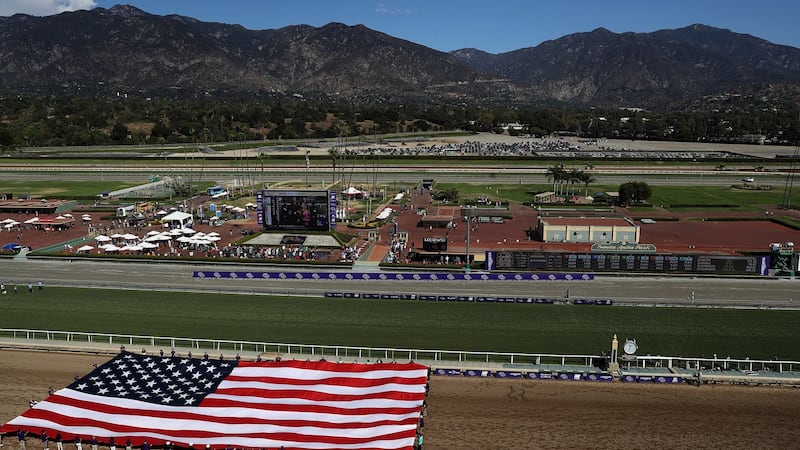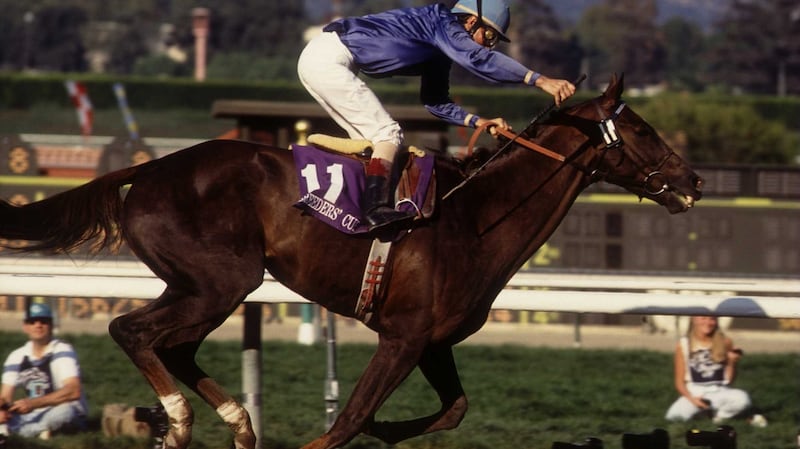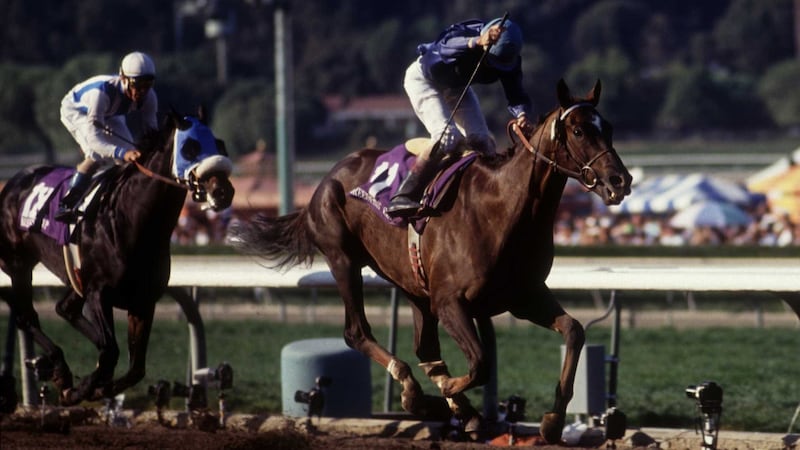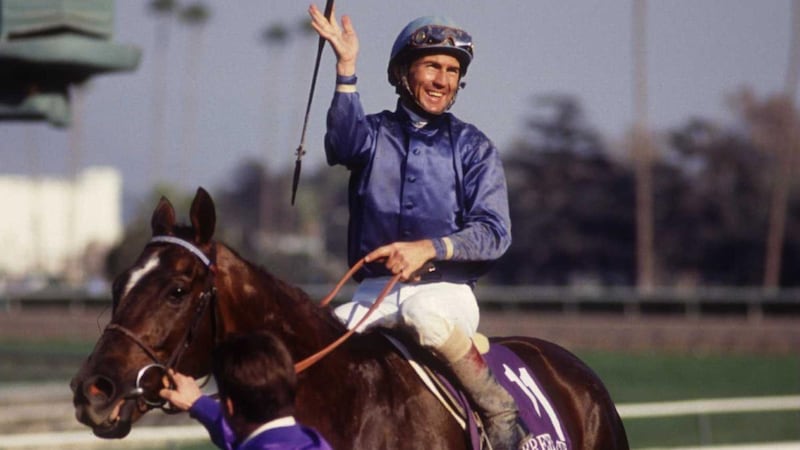The Breeders Cup is racing’s version of the Ryder Cup. It’s different in that it is annual but similar in how the rivalry only works if the Americans are ugly. Otherwise who gives a damn? There were a lot of locals being rather unlovely about their trans-Atlantic guests when the Breeders Cup train stopped at Santa Anita in 1993. What was annoying was it was easy to see why.
This was the 10th year of the concept, a series of elite races boasting huge prizemoney and designed to sell the sport to the American public. The ‘Yer-peens’ helped give a little credence to an otherwise very US kind of ‘world championship.’ And such was the quality of action in Europe at the time that a smug superiority complex accompanied some top horses to this end of season blow-out.
The problem was most of them kept getting stuffed. Even in the grass races. Dirt is the main surface in US racing, the hard, unyielding surface designed for resilience and which rewards those who gallop fastest for longest. Racing on the lawn was widely regarded as a diversion, a slightly dilettante option for horses unable to cut it on the main track or second-rate imports.
But even they kept getting the better of the best of this side of the pond. In 1986 Dancing Brave, probably the best seen in Europe for a generation, pitched up at the Santa Anita track in Los Angeles with appropriate Hollywood billing. He could finish only fourth in the mile and a half Turf. There were excuses afterwards. There always were. And by 1993 the Yanks were sick of them.
It didn’t matter that many of the excuses were valid. The American targeted the Breeders Cup at the end of November whereas for Europeans it was mostly an after-thought at the end of an arduous season. Horses travelling from the start of winter in Ireland, Britain and France often pitched up into a hot-house climate in California or Florida with just days to acclimatise.
Worst of all the pitch was horribly queered in terms of drugs. To its shame US racing continues to be an international outlier in permitting race-day medication. That includes allowing the use of Lasix, a drug justified on the basis that it helps prevent horses from bursting blood vessels but which can also be a masking agent for other substances.
It was little wonder sceptics dismissed the whole thing as the ‘Bleeders Cup.’
The connections of many raiders took an expedient attitude of when in Rome, administering Lasix in what often appeared to be less about cynicism and more about hit and hope. But still the anticipated results didn’t come, leading many American hard-boots to dismiss the interlopers as snooty bullshit artists able to talk a lot better than their horses could run.

Just like the Ryder Cup any cultural divide over the matter of one horse running faster than another is more cosmetic than real. The best European and American bloodlines have mixed for over a century. World War II had seen stallions exported to safety in Kentucky. A few decades later overseas purchasing power at the top US sales had seen much of the cream travel in reverse.
Flag waving about the outcome of elite competition between hugely wealthy bloodstock operations has always seemed a forced exercise. The great champion Nijinsky was Canadian-bred, US-owned, won England’s Triple Crown in 1970, yet got treated as Irish because he was trained in Tipperary by Vincent O’Brien.
But like the Ryder Cup it's not just the Brits who can suddenly get very European when it suits
However logic often can’t suppress the sporting instinct to take sides. So a lot of visiting fans cared a lot more than was good for them about the outcome of those seven Breeders Cup races held against the spectacular backdrop of the San Gabriel mountains 17 miles from downtown Los Angeles on Saturday, November 6th in 1993.
Two were on grass. The Mile was worth $1 million and the mile and a half which was $2 million. These are the European classic distances, what the game is all about here. If the Americans got a result in them it was bonus territory. As for the world’s richest race, the $3 million Classic over 10 furlongs on dirt, any stray Euros were advised to just stay out of the way while the big boys play.
Internationalism might be all well and good but racing on dirt is as American as apple-pie.
On the face of things it shouldn’t have to be. All races are about getting from A to B in the shortest time. All the basics are the same in terms of competition between man and beast. But the nuances are different, the technicalities subtly divergent. Perhaps the best comparison is between rugby league and rugby union: they look pretty much the same but aren’t.
It’s rare for a player to be as good in both codes and transferring with immediate success between the two is all but unheard of.
Admittedly in 1990 Dermot Weld confounded the racing world by preparing Go And Go to win the third leg of the US Triple Crown. This was a colt who'd won his very first race around the undulations of Galway the year before. But he had at least already run on dirt prior to becoming the first - and still only - European winner of an American classic.
By 1993 Weld had had a role too in this Breeders Cup rookie pitching up at Santa Anita. A few days earlier, the Irish trainer altered the face of world racing when Vintage Crop won the Melbourne Cup. Yours truly was at Flemington on a busman’s holiday and won big at 20-1. It was enough to head to LA and have it even larger.
There were no Irish runners at that Breeders Cup. But like the Ryder Cup it's not just the Brits who can suddenly get very European when it suits. Eight of 'ours' were in the Turf. Half a dozen of them were French. Five of them were trained by Andre Fabre, the 'Napoleon' of Chantilly. My dangerously confident focus though was firmly on the other one.
Hernando was the French Derby winner. He’d sank in the mud in the Arc a month before but would relish hard west coast ground. Once I’d established he’d travelled the 6,000 miles in fine form then 15-1 was the bet to end all bets. Lumping everything gained in a different hemisphere, and a little more on top, wouldn’t be so much a gamble as an investment, plus one in the eye of the home team.
There's no more attractive track anywhere in the world than Santa Anita
Long story short, I did my dough. The Americans filled the first four places. Kotashaan won. He was French-bred, owned by the people responsible for the house of Chanel, and used to be trained in France. But this was one for the home team. "And the cheers for the Americans here, they soundly defeat the Europeans," Tom Durkin, the US race-caller with the Irish name, reminded us on NBC.
Since another home champion, Lure, had won the Mile, that was that. In the pressroom there was lots of local laughter about Euro-trash, or it might have been thrash. It shouldn’t have mattered but there’s little point in being fascinated by the trivial if it doesn’t count for something. And there’s something about Americans being condescending that’s just infuriating. It was time to get out.
There's no more attractive track anywhere in the world than Santa Anita. It's art-deco stand stretches as long as the stretch. Even sold-out it was comfortable to walk the length of it. At one point Mel Brooks walked past. His latest movie was called 'Life Stinks' - I thought about it but left the great man alone.
Sitting on one of the cheap seats at the top of the straight, I watched as the runners for the final race, the Classic, got ponied to the nearby starting gates. The one familiar horse was the English runner Ezzoud. Walter Swinburn rode him. Ezzoud was a bit of a head-case even in familiar territory. First-time on dirt, with kickback slapping him in the face, he had no chance.

The only other Euro horse, I’d never heard of. Arcangues was a five-year-old veteran, the son of a soft-ground loving Arc winner, whose last start had been to finish second last in a second-rate race at Longchamp. It looked like he’d been put on the plane to LA simply to keep his more illustrious stable companions on the Fabre team company.
Who the f**ck is that?
I wasn't the only one ignorant. His jockey hadn't heard of him either. In fact Jerry Bailey, one of the top American riders, hadn't even been given instructions on how to ride Arcangues. The first time he'd set eyes on the horse was in the parade ring. The guy leading the horse up didn't speak English. As the runners were bugled onto the track, Fabre ran up and simply said 'Good Luck.'
When the gates opened at least one spectator had one eye on the horses and another on where the cheapest bus to the airport might be. The race was taking care of itself. Bailey's great rival, Gary Stevens, had put the favourite Bertrando straight to the lead. The best dirt horse in America was still there, and running easy too, as the field thundered past us at the top of the straight.
From that position it was a rear view of the finish. A pursuer came out of the pack and started to run Bertrando down. Suddenly there was no more noise anymore. For a second Santa Anita was silent. The winner went by the post to a funereal reception. Everyone looked to the big screen and a voice behind me asked ‘who the f**k is that?’
It was only bloody Arcangues. Down the centuries there have been results that have had fans and bettors rubbing their eyes in disbelief. Last month there was a record 300-1 winner at Leopardstown. Thirty years ago, Norton’s Coin won the Cheltenham Gold Cup at 100-1. But never has a big-race result produced such overwhelming incredulity as the 1993 Classic.
It remains the gold standard of ‘who the f**k is that.’ In the midst of everything it was immediately obvious this was an I-was-there-moment.

In commentary, Durkin still sounds like he can’t quite believe it - “A huge upset looming here as Arcangues comes flying on the outside. It is Arcangues to win it in an absolute shocker - he’s 99-1!” He wasn’t. The Tote board couldn’t display just how much of a no-hoper he was. Arcangues was actually 133-1.
It felt like racing’s continental plates had shifted under our feet. OK Fabre was, and is, as close to a genius as the game has known. He said later that he’d had a hunch a month beforehand and galloped Arcangues on a dirt surface. The horse glided over the unfamiliar surface. Then the only thing to worry about was to keep this elite athlete from being plagued by a bad back.
But if Fabre was sangfroid itself in the immediate aftermath, everyone else could have given Mel Brooks a tutorial in double-take. It made any future Miracle at Medinah look like a Yawn in Youghal.
“Where did that sonofabitch come from?” Stevens demanded to know.
Even Bailey couldn’t be sure. But then Bailey didn’t know how to pronounce the most valuable winner of his career, had ridden the horse “blind” because no one had told him anything beforehand, and wound up improvising to stunning effect.
“He was a European horse so I figure he could come from behind and I’d just go to the fence, try to save ground, and maybe I could get a piece of it,” he later recounted.
“I’ve always been a believer that horses run best the way they want to run. If you have no preconceived idea, and this was the definition of having no preconceived idea, then you pretty much let them run how they want to. He just had a lot more run in him than I could have ever expected,” Bailey added.
The LA Times headline summed up mood - "Too Stunned To Be Angry: Stevens, Bertrando's jockey, and trainer Bobby Frankel don't know what hit them after Arcangues' record upset."

Stevens said: “If you could have seen my face at the 16th pole you would have seen one surprised person. I was beaten but I didn’t know who had done it. I guess there was a French horse that I just didn’t know about.”
The horse pronounced ‘ar-Kong’ is still the only European runner ever to win the Classic on dirt. Over the years much more familiar names such Giant’s Causeway and Sakhee have come close. Others like Galileo and Hawk Wing barely got sighted in the race. Time has only made the outcome seem even more incredible.
On the day some visitors might have affected a few enigmatic Gallic shrugs in the stunned press room but there was no final-green crowing. After all no one anywhere appeared to have had a dime on ‘our’ winner. But it did still feel like a victory. After all what’s rare is wonderful.
And best of all Arcangues did it Lasix-free, still a lovely thing, no matter where you’re from.












